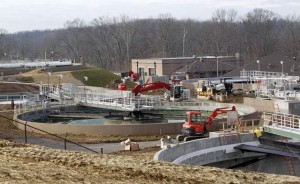Apr. 19, 2013 |
MSD is expanding capacity of its Floyds Fork treatment plant, improving its ability to remove nutrients from wastewater. MSD officials will be giving a multi-state and federal task force a tour of the construction on Friday. This photo is from 2012. JOHN SOMMERS/SPECIAL TO THE COURIER-JOURNAL.
Written by
The Courier-Journal
Nutrient pollution comes from farm and lawn fertilizer, pet and livestock waste, runoff from roads and houses, faulty septic systems, and treated sewage. It turn waters green with algae, contaminate drinking water, pollute waters for swimming and fishing and contribute to the Gulf of Mexico dead zone.
Kentucky’s top environmental regulator on Thursday said his agency was drafting a statewide plan to control pollution that causes algae blooms around the state and contributes to an oxygen-depleted “dead zone” as far away as the Gulf of Mexico. Continue reading


